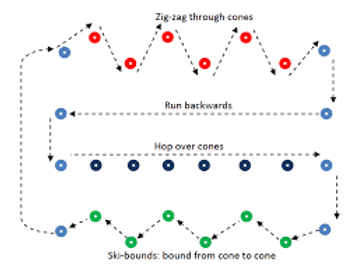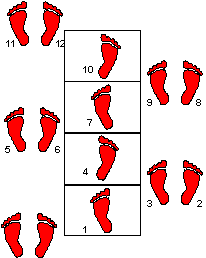AGILITY
Agility is defined as the ability to move, change direction, and position the body effectively while under control. It differs from quickness in that agility is in response to a known stimulus.
*** IMPORTANT***
Training for speed, agility, and quickness is different than most other training. The athlete MUST allow for sufficient rest between each iteration to allow for cardiorespiratory recovery. This affords the athlete the ability to perform at max effort during each iteration, which is optimal.
For a scientific look at agility with some drills outlined, click the image below.
Looking at the most popular sports being played today (baseball, football, basketball, soccer, etc.), notice that the majority of movements occur within 10 yards. These movements, which include rapid acceleration, deceleration, rotation, level changes, and changes in direction, are all characteristics of agility. Knowing that most of an athlete’s movements occur in this fashion, we can see the importance of this type of training.
In my speed section, I touched upon the importance of strength training and how that translates into a more powerful, less injury prone athlete. Those strength-training benefits apply to agility training as well. A stronger athlete will be more powerful and able to generate more force into the ground while performing change-of-direction drills (like the cone box drill). A great quote to support this concept comes from Lee Brown and Vance Ferrigno in their book, Training for Speed, Agility, and Quickness:
“The key to improving agility is to minimize the loss of speed when shifting the body’s center of gravity.”
How do we minimize that loss of speed?
Proper technique training, adequate progressions, and focusing on both acceleration and minimizing ground contact time during movements, will make the difference.
In addition to increased force production, Agility focuses on the amortization phase of training. Also called a transition phase, it is the time between the eccentric and concentric phases of a movement. Simply put, it is the ground contact time between repeated jumps.
The longer an athlete is on the ground, or the longer it takes an athlete to absorb and push off to
accelerate into a new direction, the less powerful that next movement will be. This longer transition
phase is encompassed in the stretch shortening cycle (SSC) that occurs in most activities. This is
basically comprised of three elements: the initial eccentric phase, the transition phase, and then the
concentric phase when the athlete produces a force that results in the next movement. This SSC involves storing elastic energy, the stretch reflex that will be used to powerfully move the athlete into a jump or a change of direction.
If an athlete performs a box-depth jump and pauses on the ground (transition phase) for two
seconds, then jumps onto the box, the results will suffer. The stored energy initially created in the eccentric phase will be lost and the athlete will be less powerful. With this information, it’s important to focus on improving the amortization phase of an athlete’s movements. Keep this phase as short as possible to take full advantage of the stored elastic energy that is produced in the muscles during the various movements that makeup agility.
Below you'll find a few pictures my friend Google showed me that I've taken into my library entitled "Coney Fun."




Now we transition to some fun with an agility ladder. To get really creative, combine a latter with some cones, or use tennis balls for hand-eye coordination improvement while moving through the ladder. Get creative!!!



***DISCLAIMER*** VIDEO ABOVE
Disregard her intro - when people talk about "speed & agility" it makes me twitch. They're two different entities, trained differently. Secondly, she says agility drills will improve your reaction time - this is partially true. Go to the quickness page for more on this.
"Speed & Agility" in this one, too.


